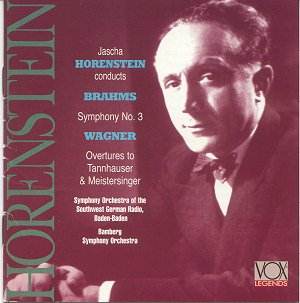BRAHMS:
Symphony No.3
WAGNER:
Overture to "Tannhauser"; Prelude to "Die Meistersinger" Act
I
 Symphony Orchestra of Southwest
German Radio, Baden-Baden
Symphony Orchestra of Southwest
German Radio, Baden-Baden
Bamberg Symphony Orchestra
Conducted by Jascha Horenstein
 (Recordings from 1958 and
1954) Vox Legends Vox
7802
(Recordings from 1958 and
1954) Vox Legends Vox
7802
Amazon
US Mid-price

The Brahms Third Symphony is a stereo recording from 1958 which was late
in Horenstein's activities for Vox. Generally it is very well balanced for
the period with only the top frequencies all out betraying real age. Though,
as with all these Horenstein re-issues, audiophiles will find them a little
"rusty" when compared with more recent recordings. For others, of course,
the music making will carry the day. The symphony opens with energy and power
and even in the lyrical second subject material Horenstein keeps a firm hand
on proceedings paying special attention to the pizzicato accompaniments.
No exposition repeat is observed, which is a pity in so short a movement,
so this gives added momentum to Horenstein's breezy, open-air quality in
the development which gets a seamless run into the recapitulation where
Horenstein's subtle control pays greatest dividends. In the second movement
I found Horenstein's more Central European sound most arresting. There is
an undoubted hint of Dvorak in the sound here that is not often noted. But
it's in the third movement where the recording scores its most notable point.
Here Horenstein seems to shift the whole emotional weight of the work to
this movement. The darker colours of the music are stressed and the tempo
is deliberate, though it never drags. It is with touches like these that
Horenstein can so often throw light on to music that we think we know very
well. I then found that the fourth movement seems to retain a little of the
mood of what precedes it. Horenstein maintains the symphonic line admirably
at what under other interpreters might be too deliberate a tempo. A fascinating
reading of Brahms's autumnal work, therefore, which it is good to see back
in the catalogue.
The two Wagner Overtures that complete this disc should remind us that Horenstein
was as much at home in the opera pit. In fact it was Parsifal at Covent Garden
that turned out to be his final conducting assignment. The Meistersinger
Act I Prelude is grand and suitably bourgeois at the start but it's the central
sections - the love music and the apprentices - that really delight. The
latter are given a light touch against that familiar Vox resonance that brings
back memories of the old LPs, and the former glows with great ardour. The
Tannhauser Overture is the version that reprises the opening material rather
than runs into the extended Venusberg music. Nevertheless, Horenstein catches
all the moods, even lifting it above that of an opera Prelude and into the
territory of symphonic poem. The Venusberg material that remains in the middle
comes over with the right degree of sensuousness and dazzle. Both overtures
are given warm and detailed mono sound that allows the Bamberg Orchestra
to shine.
Reviewer
Tony Duggan
Brahms:
Performance:

Recording:

Wagner:
Performance:

Recording:

